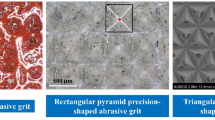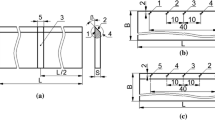Abstract
Although many studies have focused on the cutting performance of ceramic blades in processing different materials, few have reported on their application in wood processing. Thus, it is necessary to explore the cutting performance of ceramic tools in solid wood machining. The aims of this paper were to evaluate the cutting performance of Al2O3 and Si3N4 ceramic tools in the process of machining Manchurian ash (Fraxinus mandshurica Rupr.) and Chinese fir (Cunninghamia lanceolata) by means of analysing cutting force and surface roughness and to provide guidelines for factories for applying ceramic tools in the manufacture of solid wood furniture. Up-milling tests were conducted for each combination of cutting speed, tool material, and workpiece material, and each combination was replicated five times. Results showed that (1) cutting force and surface roughness decreased with increase of cutting speed and (2) cutting force and surface roughness resulting from using Al2O3 ceramic cutting tools were larger than those of Si3N4 ceramic cutting tools, especially when cutting Manchurian ash with its extractives. Overall, ceramic tools can be used in high-speed cutting of solid wood. Compared with Al2O3 ceramic cutting tools, Si3N4 ceramic cutting tools are more suitable for cutting solid wood, especially those with extractives. Si3N4 ceramic tools provided not only chemical stability, but improved final product quality.










Similar content being viewed by others
Availability of data and material
The datasets generated and analysed during the current study are available from the corresponding author on reasonable request.
Code availability
Not applicable.
References
Yang HQ, Ji CY, Nie Y, Hong YX (2012) China's wood furniture manufacturing industry: industrial cluster and export competitiveness. Forest Prod J 62(3):214–221
Chavez FC, Chaurand RA, Avila ICL (2015) Effect of subjective evaluation factors on the buying decision of residential furniture. Procedia Manuf 3:6467–6474. https://doi.org/10.1016/j.promfg.2015.07.928
Röbenack K, Ahmed D, Eckhardt S, Gottlöber C (2013) Peripheral milling of wooden materials without cutter-marks - a mechatronic approach. WSEAS Trans Appl Theor Mech 8:170–179
Vanzela M, Melega GM, Rangel S, de Araujo SA (2017) The integrated lot sizing and cutting stock problem with saw cycle constraints applied to furniture production. Comput Oper Res 79:148–160. https://doi.org/10.1016/j.cor.2016.10.015
Costes JP, Larricq P (2002) Towards high cutting speed in wood milling. Ann Forest Sci 59(8):857–865. https://doi.org/10.1051/forest:2002084
Jankowska A, Drożdżek M, Sarnowski P, Horodeński J (2017) Effect of extractives on the equilibrium moisture content and shrinkage of selected tropical wood species. BioResources 12:597–607. https://doi.org/10.15376/biores.12.1.597-607
Nzokou P, Kamdem P (2004) Influence of wood extractives on moisture sorption and wettability of red oak (Quercus rubra), black cherry (Prunus serotina), and red pine (Pinus resinosa). Wood Fiber Sci 36:483–492
Sommer F, Kern F, Gadow R (2013) Injection molding of ceramic cutting tools for wood-based materials. J Eur Ceram Soc 33(15-16):3115–3122. https://doi.org/10.1016/j.jeurceramsoc.2013.05.012
Zhu ZL, Guo XL, Ekevad M, Cao PX, Na B, Zhu NF (2017) The effects of cutting parameters and tool geometry on cutting forces and tool wear in milling high-density fiberboard with ceramic cutting tools. Int J Adv Manuf Technol 91(9-12):4033–4041. https://doi.org/10.1007/s00170-017-0085-8
Guo X, Ekevad M, Grönlund A, Marklund B, Cao P (2014) Tool wear and machined surface roughness during wood flour/polyethylene composite peripheral up-milling using cemented tungsten carbide tools. BioResources 9:3779–3791. https://doi.org/10.15376/biores.9.3.3779-3791
Sommer F, Kern F, Gadow R, Talpeanu D, Heisel U (2015) Medium density fiberboard machining and wear behavior of injection-molded ceramic composite wood cutting tools. Int J Appl Ceram Technol 12(1):147–156. https://doi.org/10.1111/ijac.12144
Wang HX, Zhao H (2016) Research on performance of mechanical ceramic cutting tool modified by graphene. China Ceram 052(006):57–61
Amaitik SM, Tasgin TT, Kilic SE (2006) Tool-life modelling of carbide and ceramic cutting tools using multi-linear regression analysis. P I Mech Eng B-J Eng 220(2):129–136. https://doi.org/10.1243/09544054jem416
Beer P, Gogolewski P, Klimke J, Krell A (2007) Tribological behaviour of sub-micron cutting-ceramics in contact with wood-based materials. Tribol Lett 27(2):155–158. https://doi.org/10.1007/s11249-007-9212-2
Guo X, He J, Qing Z, Wei H, Cao P (2017) Tribological properties of coated tool materials and wood-based materials. Linye Kexue/Scientia Silvae Sinicae 53:164–169. https://doi.org/10.11707/j.1001-7488.20171119
Xingzhong Z, Jiajun L, Baoliang Z, Hezhou M, Zhenbi L (1999) Wear behavior of Si3N4 ceramic cutting tool material against stainless steel in dry and water-lubricated conditions. Ceram Int 25(4):309–315. https://doi.org/10.1016/S0272-8842(98)00040-6
Strehler C, Graule T, Kuebler J, Ehrle B, Weinreich A, Kaiser B, Aneziris CG (2012) Lifetime and wear behavior of near net shaped Si3N4/SiC wood cutting tools. Int J Appl Ceram Technol 9(2):280–290. https://doi.org/10.1111/j.1744-7402.2011.02690.x
Zhao J (2014) The use of ceramic matrix composites for metal cutting applications. In: Low IM (ed) Advances in Ceramic Matrix Composites (2nd Edition). Woodhead Publishing, Cambridge pp 623-654. https://doi.org/10.1016/B978-0-08-102166-8.00025-6
Nasir V, Cool J (2019) Optimal power consumption and surface quality in the circular sawing process of Douglas-fir wood. Eur J Wood Wood Prod 77(4):609–617. https://doi.org/10.1007/s00107-019-01412-z
Guo XL, Li RR, Cao PX, Ekevad M, Cristovao L, Marklund B, Gronlund A (2015) Effect of average chip thickness and cutting speed on cutting forces and surface roughness during peripheral up milling of wood flour/polyvinyl chloride composite. Wood Res-Slovakia 60(1):147–156
ISO 3129:2019 (2019) Wood–sampling methods and general requirements for physical and mechanical testing of small clear wood specimens.
TAPPI T204 cm-97 (1997) Solvent extractives of wood and pulp.
Koch P, Koch P (1964) Wood machining processes.
ISO 5436–1:2000 (2000) Geometrical product specifications (GPS)–surface texture: profile method; Measurement standards–Part 1: Material measures.
Thibaut B, Denaud L, Collet R, Marchal R, Beauchene J, Mothe F, Meausoone PJ, Martin P, Larricq P, Eyma F (2016) Wood machining with a focus on French research in the last 50 years. Ann Forest Sci 73(1):163–184. https://doi.org/10.1007/s13595-015-0460-2
Deng JX, Zhang H, Wu Z, Lian YS, Xing YQ, Li SP (2012) Unlubricated friction and wear behaviors of Al2O3/TiC ceramic cutting tool materials from high temperature tribological tests. Int J Refract Met H 35:17–26. https://doi.org/10.1016/j.ijrmhm.2012.03.011
Guo XL, Zhu ZL, Ekevad M, Bao X, Cao PX (2018) The cutting performance of Al2O3 and Si3N4 ceramic cutting tools in the milling plywood. Adv Appl Ceram 117(1):16–22. https://doi.org/10.1080/17436753.2017.1368946
Okuwura S, Fujiwara Y (2007) Roughness evaluation of machined surfaces of wood. Mokuzai Gakkaishi 53(4):173–179
Acknowledgements
The authors are grateful for support from the National Natural Science Foundation of China (31971594), Kyocera for supplying the samples of ceramic cutting tools, and Power Dekor Group Co. Ltd. for supplying the samples of solid wood.
Funding
This study was funded by National Science Foundation of China (31971594).
Author information
Authors and Affiliations
Contributions
Xiaolei Guo: project administration, experiment design, analysis and discussion of the data and writing the paper.
Jinxin Wang: laboratory experiment, data collection, analysis and discussion of the data and editing the paper.
Dietrich Buck: laboratory experiment, data collection and review the paper.
Zhaolong Zhu: laboratory experiment, data collection and supervising the work.
Mats Ekevad: experiment design, laboratory experiment and supervising the work.
Corresponding author
Ethics declarations
Ethics approval
Not applicable.
Consent to participate
Not applicable.
Consent for publication
Not applicable.
Competing interests
The authors declare no competing interests.
Additional information
Publisher’s note
Springer Nature remains neutral with regard to jurisdictional claims in published maps and institutional affiliations.
Rights and permissions
About this article
Cite this article
Guo, X., Wang, J., Buck, D. et al. Cutting forces and cutting quality in the up-milling of solid wood using ceramic cutting tools. Int J Adv Manuf Technol 114, 1575–1584 (2021). https://doi.org/10.1007/s00170-021-06991-x
Received:
Accepted:
Published:
Issue Date:
DOI: https://doi.org/10.1007/s00170-021-06991-x




